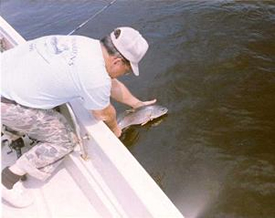Inshore Fisheries Research Section
 Red Drum - Catch and Release
Red Drum - Catch and Release
Due to the tight restrictions on both bag and size limits for red drum in South Carolina (3 fish per person per day, 15-23 inches), many of the fish you catch will be released. In addition, some anglers like to release every fish they catch.
Here are some practical tips for releasing healthy red drum based on our research results:
- Fish with non-offset circle hooks when fishing with live or natural bait. Bend the barbs down for even faster release times.
- Bring fish in quickly. Do not play fish to exhaustion.
- Release fish quickly. Do not keep fish out of water while you find your camera.
Releasing sub-adult red drum in shallow water:
- Use appropriate tackle (at least 12 lb test fishing line) and bring the fish in quickly. Fighting a fish to exhaustion may increase its possibility of dying.
- Use non-offset CIRCLE HOOKS. (We used Eagle Claw 4/0). This study has shown that circle hooks catch sub-adult red drum in the jaw over 90% of the time. Mortality is 1/5 of that with either offset circle hooks or J-hooks.
- Handle the fish only with wet hands. Use a release tool such as needle-nosed pliers to remove the hook from the mouth of the fish.
- If the point of the hook is lodged in the far back of the mouth or is beyond the crushing teeth in the back of the throat, leave the hook in place and cut the leader. A large proportion of these fish will survive.
Releasing adult red drum in deep water:
- Use appropriate tackle (at least 20 lb test line) and bring the fish in quickly. Remember, these fish are either in the act of spawing or have just recently spawned. This activity alone is EXTREMELY exhausting, and being caught on a hook adds extra stress to an already difficult time.
- Use non-offset CIRCLE HOOKS. (We used Eagle Claw 9/0 or 10/0). This study has shown that over 95% of adult red drum caught on Circle hooks are caught in the lip. Two-day mortality is half of what it is with J-hooks.
- Avoid fishing during the hottest part of the summer. Water temperatures can have a profound effect on whether a fish can revive after being caught.
- Handle the fish only with wet hands. Use a release tool such as needle-nosed pliers to remove the hook.
- It is best to leave the fish in the water. Take pictures of it there. If you must bring it into the boat, be ready to handle the fish as efficiently as possible (have all gear, cameras, etc. ready to go! These fish are unable to breathe the entire time they are out of the water.)
- Release the fish gently. If it is sluggish or floating upside down, allow it to rest for a few moments near the surface. GENTLY move it forward through the water to pass water over the gills. Most fish will regain enough strength to make it to the bottom within a minute or so.
Please visit these sites for more general tips on releasing the fish you catch!
- Release Techniques for Marine Fishes (University of Florida)
- Woo's CATCH-AND-RELEASE
This project was funded by a grant from the Cooperative Research Program of the National Marine Fisheries Service Southeast Regional Office.
